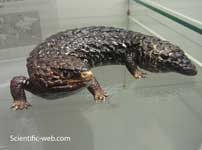Tiliqua rugosa is a short tailed and slow moving species of blue-tongued skink found in Australia. It has a heavily armored body and can be found in various colors, ranging from dark brown to cream. It is often seen sunning itself on roadsides or other paved areas. The skink is known by a variety of common names such as bobtail, shingleback, or stump-tailed skink, bogeyes, and the Pinecone or Australian sleepy lizard.[2] They have short, wide stumpy tails that resemble their head, and may confuse predators. The tail also contains fat reserves, which are drawn upon during hibernation in winter. The shingleback skink is an omnivore that eat snails and plants and spends much of its time browsing through vegetation for food. Etymology and taxonomy The species was first described by John Edward Gray in 1825 as Trachydosaurus rugosus.[2] It has since been reclassified as Tiliqua rugosa, herpetologists claim this species has more common names than any other lizard.[3] Four subspecies are currently recognized.[2]: * Tiliqua rugosa rugosa Common Shingleback: Western Australia * Tiliqua rugosa asper [4] Eastern Shingleback: eastern Australia * Tiliqua rugosa konowi [5] Rottnest Island Shingleback: Rottnest Island, Western Australia * Tiliqua rugosa palarra [6] Shark Bay Shingleback: Shark Bay, Western Australia Distribution and habitat The species is widely distributed in arid to semi-arid regions of southern and western Australia. The range extends from Shark Bay, Western Australia, across the southern-most regions of the country to the coast, then north into Queensland. Four subspecies are found in Western australia, including one at Rottnest Island. It also occurs in the eastern states of Victoria and New South Wales, but does not reach coastal areas.[7] The habitat of the species includes shrubland and desert grassland to sandy dunes. These skinks are well known, due to a preference for sun basking and open areas, and are often seen along roadsides or other cleared areas in its range.[8] Description It has a triangular shaped head, and a bright blue tongue.[3] Its short stumpy tail is similar in shape to its head. This possibly evolved as a defense mechanism against predators and has led to the common name of "two-headed skink".[3] Their short tail also contains fat reserves, which the lizard lives upon during hibernation in winter.[3] When threatened this skink offers its tail to the threat as it is autotomous.[3] The skin, muscles, blood supply, nerves and bone separate at almost any place along the length of the short tail but below the reproductive organs.[3] While the predator is distracted by the flopping, wriggling tail, the lizard makes its getaway.[3] If the predator does not attack the tail, yet remains in the area, the skink will hiss and face the threat, opening its mouth wide in order to display its blue tongue.[3] Diet Tiliqua rugosa is an omnivore that eat snails, insects, carrion, and vegetation. The species was once preyed upon by dingos, Australian pythons such as Morelia spilota, and local peoples; a threat is now more likely to come from large introduced feral species such as foxes and cats.[9]
Upon being born, the newborn young immediately consume their afterbirth.[3] The young stay with their parents for several months before moving on, however they remain in close proximity forming a colony of closely related skinks.[3] The male of a monogamous pair eats less while parenting, remaining alert and ready to give an alarm.[3] References
^ Gray, J.E. 1825. A synopsis of the genera of reptiles and Amphibia, with a description of some new species. Annals of Philosophy, 10:193—217 Retrieved from "http://en.wikipedia.org/" |
|

